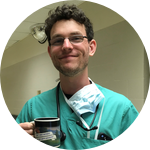About This Project
Cattle are commonly presented to veterinarians for routine and emergent medical procedures. Lower limbs are commonly evaluated by tilting cattle on their sides in a special chute. However, it is currently unknown if cattle (weighing up to 1000-2500 lb.) when on their sides can ventilate effectively. If not, they may require supplemental oxygen during these procedures. We will assess ventilation and if while on their sides, supplied oxygen may improve their welfare.
Ask the Scientists
Join The DiscussionWhat is the context of this research?
Cattle are commonly examined by veterinarians for lameness and lower limb concerns. Cattle are tilted on their sides to achieve safe access to affected areas. These cattle are often extremely large mammals (1-2000+/- lb.). Being on their sides for a prolonged period is unnatural and may impede the cattle's ability to breath and ventilate. Subsequently, this can result in low blood oxygen levels as occurs in other large mammals (e.g., horses). This has not been evaluated in cattle and could expose a welfare problem that is very easily addressed. These patients may require oxygen therapy during exams; however, this is currently unknown.
What is the significance of this project?
The significance is that tens of thousands of cattle are seen by veterinarians annually within the United States and a significant portion of them may required to be tilted on their side to facilitate treatment and examination. Inability to ventilate effectively is a simple question to answer and quite important as it can lead to altered blood gas tensions and potentially put their health and comfort at risk. Inability to oxygenate because of poor ventilation can lead to significant discomfort in that these patients may experience something called air hunger ( a substantial drive for oxygen ). This clinical problem is aimed to be simply answered and may impact patient's welfare across veterinary medicine.
What are the goals of the project?
The goals of the project are simple:
1. Determine the significance of tilting a cow or bull on its side by assessing ventilatory status and potential affects on blood pH, oxygenation of red blood cells, and blood carbon dioxide levels. This will be accomplished by performing blood gas analysis prior to tilting (standing), then every 10 minutes until examination/treatment is complete.
2. Blood samples will be assessed on a bedside basis (real time). If blood oxygen levels demonstrate that the patients would benefit from supplemental oxygen, 100% oxygen will be administered into a nasal passage at 15 liters per minute. At least one additional blood gas analysis will be performed following oxygen supplementation to document the effect of this intervention.
Budget
Arterial blood gas analysis is used to look at blood samples taken from the patients (with owner consent) to measure the gas tensions (e.g., oxygen and carbon dioxide) and blood pH. These parameters assess how well the cattle ventilate and oxygenate while tilted. This will be performed by a blood gas analyzer which quickly measures these parameters using calibrated cartridges (1 cartridge per sample).
Blood collections will be taken from an arterial vessel easily accessed on each patient's ear. These supplies include heparin to ensure the samples do not coagulate, syringes, needles, and solutions to clear the ear prior to taking samples.
Statistical analysis will be performed on the data to determine if there are significant effects of tilting the cattle on their sides, on their ability to ventilate and oxygenate.
Endorsed by
 Project Timeline
Project Timeline
Oct 30: have IACUC protocol approved. This review process will ensure the project's scope and methods are ethical in nature prior to data collections.
Nov. 20: begin enrolling patients with owner consent for data collection.
Dec 30 - post-research update on data collected thus far.
Jan 30 - complete data collection and begin analysis.
Feb 28 - submit manuscript to the Journal of the Amer. Vet Med Assoc.
Sep 25, 2021
Project Launched
Nov 20, 2021
Begin enrolling patients
Jan 30, 2022
Finish enrolling patients and begin data analysis
Feb 28, 2022
Submit manuscript for publication
Meet the Team
Team Bio
The team for this project is led by Nathaniel Kapaldo. As an anesthesiologist, Dr Kapaldo is uniquely suited to understanding the implications of large body mass, recumbency, and potential derangement of blood gas levels. This project will include four additional large animal focused boarded veterinary specialists who will assist in patient selection, getting owner consent, and data collection. Veterinary student instruction and education on this topic will occur also.
Nathaniel Kapaldo
Currently an Assistant Professor of veterinary anesthesiology at the Veterinary Health Center of the Kansas State University College of Veterinary Medicine (KSU-CVM). Education includes: Bachelors of Science in Biology (2009) from Slippery Rock University (PA), Masters of Public Health with emphasis on infectious and zoonotic diseases (2017) and Doctor of Veterinary Medicine both from KSU-CVM (2017), internship in small animal medicine and surgery at the Animal Medical Center in New York City (2018), residency in veterinary anesthesia and analgesia KSU-CVM (2021).
I work in a unique field in that I can be involved in the care of many different species and while also collaborating with human counterpart anesthesiologists to service both human and veterinary patients. My underlying research interests are answering simple questions which may have larger impacts on a population of patients thereby improving perioperative safety and morbidity. Other research interests include investigating urine partial pressure of oxygen as a proxy for renal perfusion and oxygenation in patients under anesthesia and veterinary locoregional anesthesia.
I intermittently will give lectures for the Anesthesia Department at the ICahn School of Medicine at Mount Sinai (NYC).
Additional Information
Some cattle may be given mild sedatives to reduce stress during these examinations and also provide some pain relief. However, these same drugs can result in altered ventilation and oxygenation in ruminants (cattle) and so these patients may be at additional risk of having altered blood gas levels when tilted.
Project Backers
- 13Backers
- 100%Funded
- $2,150Total Donations
- $165.38Average Donation


